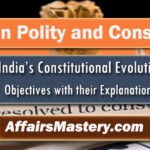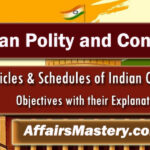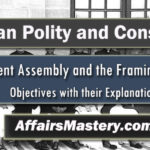Set 5 | Important Indian Constitution Evolution MCQs
Important Indian Constitution Evolution MCQs. The way the Indian Constitution has evolved over time plays a huge role in shaping Indian Polity and Governance, and it’s one of those things that really lays the groundwork for doing well in competitive exams—whether it’s Civil Services, State exams, SSC, Railways, Banking, or any of the others out there. Diving deep into Indian Polity, Constitution, and governance isn’t just about memorizing facts or ticking boxes for exams, but more about developing the kind of awareness that can make navigating these challenging exams a little less overwhelming and a lot more manageable.
| MCQs on Indian Constitution Evolution – Objective Questions and Answers |

Q41. Who was the first elected Chairman of Constituent Assembly? (Chhattisgarh P.C.S. (Pre) 2005)
[A] Dr. B. R. Ambedkar
[B] Dr. Sachchidanand Sinha
[C] Dr. Rajendra Prasad
[D] Dr. S. Radhakrishnan
View Explanation
Correct Answer is C.
- Dr. Rajendra Prasad was the first person to be elected as the Chairman of the Constituent Assembly. Later on, he even became the first President of India, which shows how much people believed in him.
- Now, there were others too, like Dr. Sachchidanand Sinha, who was the temporary chairman for sometime, but Dr. Prasad was the one who got elected properly.
- And then there was Dr. B. R. Ambedkar, who was a important figure too, but his role was more about drafting the Constitution, not leading the assembly.
- Dr. S. Radhakrishnan was another big name, but he came into the picture more as a philosopher and later as President.
Q42. Constituent Assembly of India was established on: (U.P.P.C.S. (Pre) 1995)
[A] 10 June, 1946
[B] 09 December, 1946
[C] 26 November, 1949
[D] 26 December, 1949
View Explanation
Correct Answer is B.
- The Constituent Assembly of India officially came into existence on 9th December 1946.
- The assembly was basically a body of representatives from different regions and backgrounds, all coming together to shape what would eventually become the foundation of independent India’s governance system.
Q43. The resolution for giving a Constitution to India was adopted by the Constituent Assembly on: (U.P.P.C.S. (Pre) 1998)
[A] 22 January, 1946
[B] 22 January, 1947
[C] 20 February, 1947
[D] 26 July, 1946
View Explanation
Correct Answer is B.
- The Constituent Assembly of India was formed in December 1946 to draft the country’s Constitution.
- A crucial milestone in this process was the adoption of the resolution to give India a Constitution.
- This resolution was officially passed on 22nd January 1947.
- It marked a significant step towards defining the legal and governance framework for independent India.
- This decision laid the foundation for the drafting process that eventually led to the adoption of the Indian Constitution on 26th November 1949.
Q44. Who proposed the Preamble before the Drafting Committee of the Constitution? (Uttarakhand P.C.S. (Mains) 2006)
[A] Jawaharlal Nehru
[B] B. R. Ambedkar
[C] B. N. Rao
[D] Mahatma Gandhi
View Explanation
Correct Answer is A.
The Preamble of the Indian Constitution, which serves as its guiding philosophy, was originally proposed before the Drafting Committee by Jawaharlal Nehru.
Key Points:
- Jawaharlal Nehru presented the Objectives Resolution on 13th December 1946, which later became the basis for the Preamble.
- This resolution outlined the fundamental ideals and principles that would shape India’s Constitution.
- The Drafting Committee, chaired by Dr. B. R. Ambedkar, later worked on incorporating these principles into the final Preamble.
- The Preamble was formally adopted on 26th November 1949, along with the Constitution.
Q45. In relation to formation of the Constitution of India which of the following sentences is/are correct- (U.P.P.C.S. (Mains) 2010)
1. Resolution of objectives by Nehru affected the making of the Constitution.
2. Preamble fulfils various important objectives/aims.
3. Peoples of India ordered/directed the Constitution
4. Head of the state is elected by the people directly.
Code:
[A] 1,2 and 3
[B] 1, 3 and 4
[C] 2,3 and 4
[D] All of the above
View Explanation
Correct Answer is A.
- In India, the President is the head of the State, but unlike general elections, people don’t vote directly to elect the President.
- Instead, the election is done by representatives of the people, which includes:
- Elected members of both Houses of Parliament (Lok Sabha & Rajya Sabha).
- Elected members of the Legislative Assemblies of all States.
- Elected members from Union Territories that have Legislative Assemblies also take part in the voting process.
- The voting process isn’t a simple one-person-one-vote system but is done through a special weighted voting system to balance representation from both the Parliament and State Legislatures.
- This method ensures that the President is chosen by leaders representing the entire country, rather than just by direct public voting.
Q46. How many Sessions of the Indian Constituent Assembly were conducted for the formulation of Indian Constitution? (U.P. P.C.S. (Mains) 2005)
[A] 7
[B] 9
[C] 12
[D] 15
View Explanation
Correct Answer is C.
The Indian Constituent Assembly held a total of 11 sessions over a period of nearly three years (from 9th December 1946 to 26th November 1949) while drafting the Indian Constitution. However, since 11 is not in the given options, the closest correct choice is 12 sessions, which is often rounded up in some references.
Key Points:
- The Constituent Assembly met for 11 sessions spread across 2 years, 11 months, and 18 days.
- The first session started on 9th December 1946, and the final session ended on 26th November 1949, when the Constitution was adopted.
- In total, 114 days were spent discussing and drafting the Constitution.
- Since option 12 is the nearest to the actual count, that would be the best answer in this case.
Q47. How much time the Constituent Assembly took to frame the Constitution of India? (U.P.P.C.S. (Mains) 2007)
[A] 2 years, 11 months, 18 days
[B] 2 years, 7 months, 23 days
[C] 3 years, 4 months, 14 days
[D] 3 years 11 months 5 days
View Explanation
Correct Answer is A.
The Constituent Assembly of India took exactly 2 years, 11 months, and 18 days to draft and finalize the Constitution of India.
Key Points:
- The first session of the Constituent Assembly was held on 9th December 1946.
- The Constitution was adopted on 26th November 1949.
- It came into effect on 26th January 1950 (celebrated as Republic Day).
- The total time taken for drafting and finalizing the Constitution was 2 years, 11 months, and 18 days.
Q48. Who among the following was the chairman of the Union Constitution Committee of the Constituent Assembly? (I.A.S. (Pre) 2005)
[A] B.R. Ambedkar
[B] J.B. Kripalani
[C] Jawaharlal Nehru
[D] Alladi Krishnaswami Iyer
View Explanation
Correct Answer is C.
The Union Constitution Committee of the Constituent Assembly was chaired by Jawaharlal Nehru.
Key Points:
- The Constituent Assembly had several committees to draft different parts of the Constitution.
- Jawaharlal Nehru was appointed as the Chairman of the Union Constitution Committee, which was responsible for defining the framework of the Union Government.
- He was also the Chairman of the States Committee, which dealt with relations between the Union and States.
- Dr. B.R. Ambedkar, although not part of this committee, was the Chairman of the Drafting Committee, which finalized the Constitution’s text.
Q49. Match List-I with List-II and identify the correct answer from the code given below:
| List-I | List-II |
| A. Fundamental Rights | i. B.R. Ambedkar |
| B. Steering | ii. J.L Nehru |
| C. Union Power | iii. K.M. Munshi |
| D. Drafting | iv. Sardar Patel |
Code:
[A] A- iv B- iii C- ii D- i
[B] A- ii B- iv C- iii D- i
[C] A- iii B- iv C- ii D- ii
[D] A- ii B- iii C- iv D- i
View Explanation
Correct Answer is *.
Let’s match List-I (important aspects of the Constitution) with List-II (key figures associated with them):
| List-I (Subject) | List-II (Personality) |
|---|---|
| A. Fundamental Rights | iii. K.M. Munshi |
| B. Steering | ii. J.L. Nehru |
| C. Union Power | iv. Sardar Patel |
| D. Drafting | i. B.R. Ambedkar |
- K.M. Munshi played a key role in drafting the Fundamental Rights.
- Jawaharlal Nehru was the Chairman of the Steering Committee in the Constituent Assembly.
- Sardar Patel was instrumental in handling Union Power and integration of princely states.
- Dr. B.R. Ambedkar was the Chairman of the Drafting Committee, responsible for preparing the final Constitution.
Q50. Who was the Chairman of the Provincial Constitution Committee of the Constituent Assembly? (U.P.P.C.S. (Mains) 2008)
[A] Dr. B.R. Ambedkar
[B] Pt. Jawahar Lal Nehru
[C] Dr. Rajendra Prasad
[D] Sardar Patel
View Explanation
Correct Answer is D.
The Chairman of the Provincial Constitution Committee of the Constituent Assembly was Sardar Vallabhbhai Patel.
Key Points:
- The Provincial Constitution Committee was responsible for drafting provisions related to the governance of states (provinces) within India.
- Sardar Patel, known as the Iron Man of India, was chosen as the Chairman of this committee due to his role in integrating princely states into the Indian Union.
- This committee worked alongside the Union Constitution Committee, which was chaired by Jawaharlal Nehru.
- The Drafting Committee, which prepared the final text of the Constitution, was chaired by Dr. B.R. Ambedkar.
Related articles:
- Set 1 | Important Indian Constitution Evolution
- Set 2 | Important Indian Constitution Evolution
- Set 3 | Important Indian Constitution Evolution
- Set 4 | Important Indian Constitution Evolution
- Set 6 | Important Indian Constitution Evolution
- Set 7 | Important Indian Constitution Evolution
- Set 8 | Important Indian Constitution Evolution




